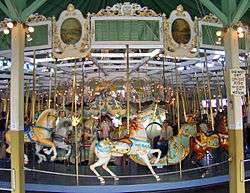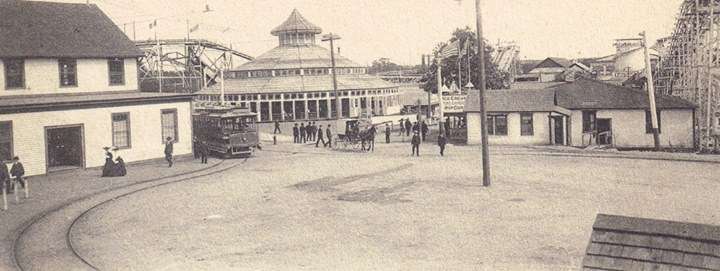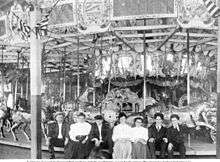Crescent Park Looff Carousel
Crescent Park Looff Carousel, also known as Crescent Park Carousel or more officially as Crescent Park Looff Carousel and Shelter Building, is a National Historic Landmark in East Providence, Rhode Island.
Crescent Park Looff Carousel | |
 Riders on carousel, 2008 | |
  | |
| Location | Bullock's Point Ave., East Providence, Rhode Island |
|---|---|
| Coordinates | 41°45′23″N 71°21′33″W |
| Built | 1895 |
| Architect | Charles I.D. Looff |
| MPS | East Providence MRA (AD) (2.6MB) |
| NRHP reference No. | 76000045 |
| Significant dates | |
| Added to NRHP | April 21, 1976[1] |
| Designated NHL | February 27, 1987[2] |
The hand-carved carousel was built in 1895 by Charles I. D. Looff at his Brooklyn, New York factory and installed at Crescent Park Amusement Park in the Riverside section of East Providence, Rhode Island. The ride's fifty-foot platform contains sixty-one horses, one camel, two single coaches, and two double chariots. Fifty-six of the horses are jumpers. It is among the finest and least-altered of Looff's surviving carousels, serving as a showcase for his workmanship.
History
Charles I. D. Looff was born in Denmark in 1852 and immigrated to the United States in 1870. He built the first carousel at Coney Island in 1876. From his Brooklyn factory, Looff built many carousels for the East coast and places like the Texas State Fair in Dallas, the Oklahoma State Fair in Oklahoma City, as well as Houston and Fort Worth. In 1905, Looff moved his factory to Crescent Park and used this carousel as a showpiece for customers to select the horses that they wanted on their rides. Most of the figures on this carousel were carved between 1905 and 1910 when Looff moved his factory to Long Beach, California. Of almost fifty carousels that Looff built between 1875 and 1918, this is one of the ten or twelve remaining in operation.
When Crescent Park closed in 1977, the City of East Providence kept the carousel off of the auction block after being pressured by local coalitions in a lengthy legal battle.[3] The restored ride continues to operate every summer and is controlled by a commission of eighteen bureaucrats who maintain statutory authority over a dynastic managerial and operational staff.[4]
The carousel was listed on the National Register of Historic Places in 1976, and was declared a National Historic Landmark in 1987.[2][5] The Rhode Island General Assembly proclaimed the carousel as "the State Jewel of American Folk Art."
Building
The carousel is housed in one of Looff's classic "hippodrome" buildings topped with his traditional onion dome. Sunlight floods through multicolored clerestory windows and reflects off of faceted mirrors to create a magical kaleidoscope effect. The carousel is circled by several rows of wooden benches and a rope fence. Tickets are purchased from a free-standing booth located just inside the entrance and opposite from a small gift and snack stand. Adjacent to this stand is a small exhibit of historical artifacts. Vents at the roof's peak provide natural air circulation. A full-sized hand-carved American bald eagle sits atop the rides center pole. Managerial offices are located in a pavilion annex opposite the main access road which was formerly Looff's on-site workshop.
Rides
Rides begin and end when a brass fog bell manufactured by PERKO Inc. is rung.[6] The duration of the ride is determined with the help of a small hourglass affixed to the snare drum cabinet of the band organ. It is one of the only carousels in America where riders can play the ring game by grabbing a brass ring to earn a free ride. After catching the rings, riders throw them into the cut-out mouth of a clown face painted on a large canvas. Originally, the ride was powered by steam from the park's steam plant. The carousel is currently operated by an electric motor.
Band organ

See also
- Flying Horse Carousel, a National Historic Landmark carousel in Watch Hill, Rhode Island
- List of National Historic Landmarks in Rhode Island
- National Register of Historic Places listings in Providence County, Rhode Island
References
- "National Register Information System". National Register of Historic Places. National Park Service. January 23, 2007.
- "Crescent Park Looff Carousel". National Historic Landmark summary listing. National Park Service. Archived from the original on 2010-11-23. Retrieved 2008-05-04.
- Rodericks, Bob (6 August 2013). "The Coney Island of the East Coast". Reporter Today. Retrieved 4 June 2018.
- "Archived copy". Archived from the original on 2010-06-02. Retrieved 2010-02-28.CS1 maint: archived copy as title (link) Carousel Park Commission
- James H. Charleton (October 1985). "National Register of Historic Places Inventory-Nomination: Crescent Park Looff Carousel and Shelter Building" (pdf). National Park Service. Cite journal requires
|journal=(help) and Accompanying one photo, exterior, from early 1900s (32 KB) - PERKO Inc.
- Census of Classic Wood Carousels
- Projo.com archives, "Looff Carousel ornaments stolen"
Images
| Wikimedia Commons has media related to Crescent Park Carousel. |
 Crescent Park Looff Carousel and midway c.1905
Crescent Park Looff Carousel and midway c.1905 Looff family at Crescent Park mgr c.1905-1910
Looff family at Crescent Park mgr c.1905-1910.jpg) Crescent Park carousel in 2007
Crescent Park carousel in 2007